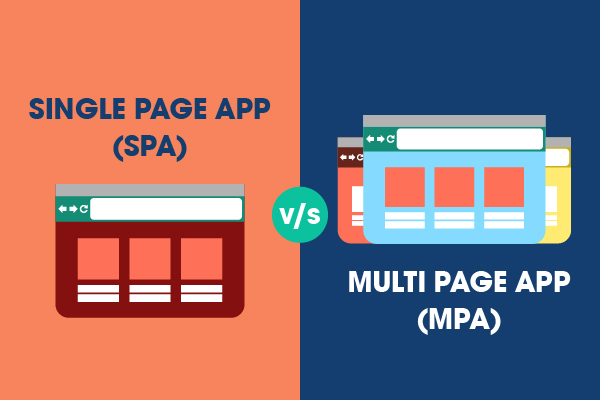Single Page Application (SPA) vs Multiple Page Application (MPA)
The success of any project largely depends on the choice of the correct technology stack – a wrong decision on the fundamental architecture has the potential of making or breaking your plan. Old desktop application is not in trend and is replaced by web apps. The reason to choose a web-based app is its flexibility.
At present, there is a single page app (SPA) and multi page app (MPA) design pattern in trend. Whatever method you use to create an application, you need to take its security seriously for example, developers can sign application code with Code Signing certificate to stop any data tampering by cyber thieves. So, let us discuss the difference between Single Page Application and Multiple Page Application and when to choose them.

What is a Single Page Application (SPA)?
Single Page Application is an approach where every page of the website is dynamically generated by using JavaScript to manipulate the DOM (Document Object Model) of the page being served.
Single page applications allow users to interact with the site while page loads or updates its elements in the background, resulting in quicker content reloading and communication. SPA works by making use of Web Sockets or AJAX to fetch the content dynamically, so the current page stays in focus while the requests to fetch information from the server are made in the background.
When should you use Single Page Applications (SPAs)?
Here are some scenarios that may benefit from the use of single page application architecture:
SPAs use local data stores, which allows page rendering even when the user is offline. This approach also limits the amount of data transferred compared to the traditional websites where all content (like HTML and CSS) is loaded for every single page – this leads to better performance as the users get to view the page content faster.
Single page apps allow the development of related pages as the same page since the content can easily be altered based on the request. This saves development time and cost.
Advantages of Single Page Apps (SPAs)
Here are a few key pros of using the SPA architecture:
1. Responsive and Fast
Updating just the required content instead of loading the entire page helps improve website speed. This leads to a noticeable positive impact on your online business and the sales it generates.
2. Caching
Single Page Apps are very effective in caching local data – only one request is sent to the webserver and the data received is stored at the client end. This information can be used when working offline or through bad connectivity. The local data is synced with the backend when the connection is re-established.
3. Linear experience
Single page application delivers a purely linear experience – scrolling becomes better and uninterrupted. The user does not have to click around unnecessarily – this convenient scrolling feature makes for better user experience on mobile devices.
4. Debugging
Tools provide within Google chrome and development toolkits shipped with various SPA development frameworks make it easy to debug single page apps. SPA debugging kits also allow you to monitor network traffic patterns and investigate page elements/data.
Disadvantages of Single Page Apps (SPAs)
Some of the cons of using the SPA architecture are:
1. Reduced SEO optimization
It is hard to optimize SEO for SPAs as they make heavy use of JavaScript and fetch data on request. The URL does not really change, which means multiple pages have the same address. This makes it harder for search engines to optimize these websites since most bots are unable to scan most of the pages.
2. Browsing history loss
Single page apps do not save the transitions between the states – this means the users cannot use the back button to go to the previous state. The browser can only navigate to the previous page, not the prior application state.
3. Security concerns
SPAs are more prone to cross-site scripting attacks as compared to MPAs, which makes it easier for hackers to inject malicious client-side scripts into the pages. Also, the user’s sensitive data may be exposed, and they won’t even know because all of it is not generally visible on the web browser.
What tools and frameworks can you use to build SPAs?
The key to extending the reach of single page apps is the use of JavaScript and its ease of use as part of various frameworks. Some of the popular SPA frameworks used by web developers include:
- Angular JS
- Backbone
- React
- Knockout
- Meteor JS
There are more options besides these, and every single page application development framework comes with its pros, cons, and toolkits. So, pick the one that suits your development style – these frameworks make it easy for you to implement the SPA concepts in your web application.
What is a Multiple Page Application?
Multiple page application contains various pages loaded with static information like images, text and links to other pages. When transitioning from one page to another, the browser reloads the entire page content and downloads all page resources again – this also includes repeated components.
HTML and CSS form these two technologies used for developing MPAs.
When should you use Multiple Page Applications (MPAs)?
Using multi-page app architecture is more suited for businesses that provide a wide variety of products and services, which requires you to work with multiple menus and several features. MPAs are ideal for developing business websites, online stores, and marketplaces where the user base is diverse, or the site has a lot of features and content.
Advantages of Multi Page Apps (MPAs)
Here are a few key pros of using the MPA architecture:
1. Better SEO
MPAs is a better choice for SEO as it works seamlessly with search engine crawlers. You get better control over the SEO aspects since you can tune each page and content differently – like appropriate META tags and use of different keywords for better SEO optimization of each web page.
2. Increased Scalability
Multiple page applications let you create fresh content and serve it on new pages. MPAs make it easy for you to include large amounts of information related to your products and services, without the page limitations imposed by the SPA architecture. Thus, if you are looking for more features, multi-page apps are a better option for you.
3. Improved Analytics insights
MPAs provide better analytics compared to SPAs when it comes to data related to site performance. Single page applications limit the amount of useful information you can gather with tools like Google Analytics – all you get to know is who the visitors are and how much time they spent on the site.
Disadvantages of Multi Page Apps (MPAs)
Some of the cons of using the MPA architecture are:
1. Poor Speed and Performance
With MPAs, the server has to reload most of the content and page resources, such as HTML and CSS, for every interaction – the same is true for loading another page, even if there are repeated page components throughout the site. This leads to reduced speed and performance of the application.
2. Increased development time
In most MPA development scenarios, the web developers have to begin coding the backend from scratch every time. Separation of frontend and backend code becomes a pain due to the close interactions between the two. This leads to the use of different frameworks for each end, which results in longer app development time and hence cost.
3. Harder to maintain and update
Multiple page apps are harder to maintain and update, and things get worse as the site gets larger. Ensuring security also becomes more difficult as each page needs to be secured separately. On the other hand, SPAs make it easy for the developers to secure the data endpoints.
So how do you take a single page app vs multiple page app decision? Well, it all depends on the goals and objectives of your online business. If you have a large number of categories and have to deal with a vast amount of content, choose MPA. If you want to provide your users with a modern single page experience, pick SPA. No matter what you pick, make sure you evaluate your decision based on the points discussed in this article.


